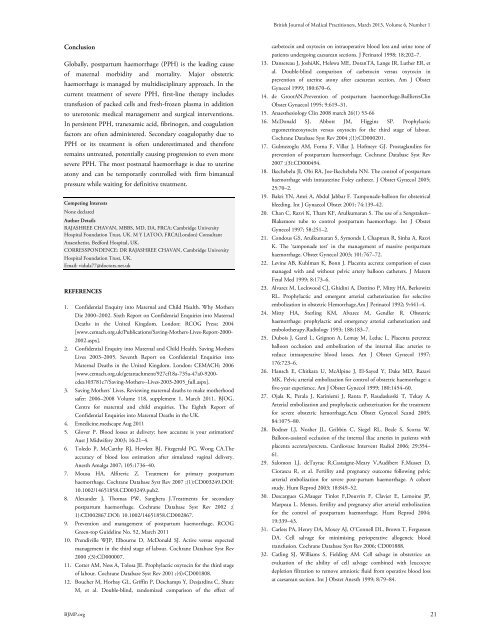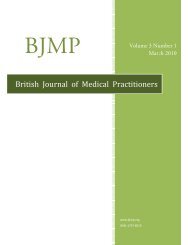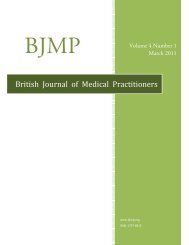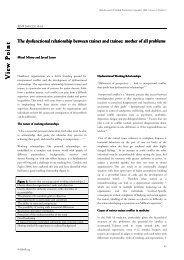R esearch A rticle - British Journal of Medical Practitioners
R esearch A rticle - British Journal of Medical Practitioners
R esearch A rticle - British Journal of Medical Practitioners
Create successful ePaper yourself
Turn your PDF publications into a flip-book with our unique Google optimized e-Paper software.
<strong>British</strong> <strong>Journal</strong> <strong>of</strong> <strong>Medical</strong> <strong>Practitioners</strong>, March 2013, Volume 6, Number 1<br />
Conclusion<br />
Globally, postpartum haemorrhage (PPH) is the leading cause<br />
<strong>of</strong> maternal morbidity and mortality. Major obstetric<br />
haemorrhage is managed by multidisciplinary approach. In the<br />
current treatment <strong>of</strong> severe PPH, first-line therapy includes<br />
transfusion <strong>of</strong> packed cells and fresh-frozen plasma in addition<br />
to uterotonic medical management and surgical interventions.<br />
In persistent PPH, tranexamic acid, fibrinogen, and coagulation<br />
factors are <strong>of</strong>ten administered. Secondary coagulopathy due to<br />
PPH or its treatment is <strong>of</strong>ten underestimated and therefore<br />
remains untreated, potentially causing progression to even more<br />
severe PPH. The most postnatal haemorrhage is due to uterine<br />
atony and can be temporarily controlled with firm bimanual<br />
pressure while waiting for definitive treatment.<br />
Competing Interests<br />
None declared<br />
Author Details<br />
RAJASHREE CHAVAN, MBBS, MD, DA, FRCA; Cambridge University<br />
Hospital Foundation Trust, UK. M Y LATOO, FRCA(London) Consultant<br />
Anaesthetist, Bedford Hospital, UK.<br />
CORRESSPONDENCE: DR RAJASHREE CHAVAN, Cambridge University<br />
Hospital Foundation Trust, UK.<br />
Email: vidula77@doctors.net.uk<br />
REFERENCES<br />
1. Confidential Enquiry into Maternal and Child Health. Why Mothers<br />
Die 2000–2002. Sixth Report on Confidential Enquiries into Maternal<br />
Deaths in the United Kingdom. London: RCOG Press; 2004<br />
[www.cemach.org.uk/Publications/Saving-Mothers-Lives-Report-2000-<br />
2002.aspx].<br />
2. Confidential Enquiry into Maternal and Child Health. Saving Mothers<br />
Lives 2003–2005. Seventh Report on Confidential Enquiries into<br />
Maternal Deaths in the United Kingdom. London: CEMACH; 2006<br />
[www.cemach.org.uk/getattachment/927cf18a-735a-47a0-9200-<br />
cdea103781c7/Saving-Mothers--Lives-2003-2005_full.aspx].<br />
3. Saving Mothers’ Lives, Reviewing maternal deaths to make motherhood<br />
safer: 2006–2008 Volume 118, supplement 1, March 2011, BJOG,<br />
Centre for maternal and child enquiries. The Eighth Report <strong>of</strong><br />
Confidential Enquiries into Maternal Deaths in the UK.<br />
4. Emedicine.medscape Aug 2011<br />
5. Glover P. Blood losses at delivery: how accurate is your estimation<br />
Aust J Midwifery 2003; 16:21–4.<br />
6. Toledo P, McCarthy RJ, Hewlett BJ, Fitzgerald PC, Wong CA.The<br />
accuracy <strong>of</strong> blood loss estimation after simulated vaginal delivery.<br />
Anesth Amalga 2007; 105:1736–40.<br />
7. Mousa HA, Alfirevic Z. Treatment for primary postpartum<br />
haemorrhage. Cochrane Database Syst Rev 2007 ;(1):CD003249.DOI:<br />
10.1002/14651858.CD003249.pub2.<br />
8. Alexander J, Thomas PW, Sanghera J.Treatments for secondary<br />
postpartum haemorrhage. Cochrane Database Syst Rev 2002 ;(<br />
1):CD002867.DOI: 10.1002/14651858.CD002867.<br />
9. Prevention and management <strong>of</strong> postpartum haemorrhage, RCOG<br />
Green-top Guideline No. 52, March 2011<br />
10. Prendiville WJP, Elbourne D, McDonald SJ. Active versus expected<br />
management in the third stage <strong>of</strong> labour. Cochrane Database Syst Rev<br />
2000 ;(3):CD000007.<br />
11. Cotter AM, Ness A, Tolosa JE. Prophylactic oxytocin for the third stage<br />
<strong>of</strong> labour. Cochrane Database Syst Rev 2001 ;(4):CD001808.<br />
12. Boucher M, Horbay GL, Griffin P, Deschamps Y, Desjardins C, Shutz<br />
M, et al. Double-blind, randomized comparison <strong>of</strong> the effect <strong>of</strong><br />
carbetocin and oxytocin on intraoperative blood loss and urine tone <strong>of</strong><br />
patients undergoing caesarean sections. J Perinatol 1998; 18:202–7.<br />
13. Dansereau J, JoshiAK, Helewa ME, DoranTA, Lange IR, Luther ER, et<br />
al. Double-blind comparison <strong>of</strong> carbetocin versus oxytocin in<br />
prevention <strong>of</strong> uterine atony after caesarean section. Am J Obstet<br />
Gynecol 1999; 180:670–6.<br />
14. de GrootAN.Prevention <strong>of</strong> postpartum haemorrhage.BaillieresClin<br />
Obstet Gynaecol 1995; 9:619–31.<br />
15. Anaesthesiology Clin 2008 march 26(1) 53-66<br />
16. McDonald SJ, Abbott JM, Higgins SP. Prophylactic<br />
ergometrineoxytocin versus oxytocin for the third stage <strong>of</strong> labour.<br />
Cochrane Database Syst Rev 2004 ;(1):CD000201.<br />
17. Gulmezoglu AM, Forna F, Villar J, H<strong>of</strong>meyr GJ. Prostaglandins for<br />
prevention <strong>of</strong> postpartum haemorrhage. Cochrane Database Syst Rev<br />
2007 ;(3):CD000494.<br />
18. Ikechebelu JI, Obi RA, Joe-Ikechebelu NN. The control <strong>of</strong> postpartum<br />
haemorrhage with intrauterine Foley catheter. J Obstet Gynecol 2005;<br />
25:70–2.<br />
19. Bakri YN, Amri A, Abdul Jabbar F. Tamponade-balloon for obstetrical<br />
bleeding. Int J Gynaecol Obstet 2001; 74:139–42.<br />
20. Chan C, Razvi K, Tham KF, Arulkumaran S. The use <strong>of</strong> a Sengstaken–<br />
Blakemore tube to control postpartum haemorrhage. Int J Obstet<br />
Gynecol 1997; 58:251–2.<br />
21. Condous GS, Arulkumaran S, Symonds I, Chapman R, Sinha A, Razvi<br />
K. The ‘tamponade test’ in the management <strong>of</strong> massive postpartum<br />
haemorrhage. Obstet Gynecol 2003; 101:767–72.<br />
22. Levine AB, Kuhlman K, Bonn J. Placenta accreta: comparison <strong>of</strong> cases<br />
managed with and without pelvic artery balloon catheters. J Matern<br />
Fetal Med 1999; 8:173–6.<br />
23. Alvarez M, Lockwood CJ, Ghidini A, Dottino P, Mitty HA, Berkowitz<br />
RL. Prophylactic and emergent arterial catheterization for selective<br />
embolization in obstetric Hemorrhage.Am J Perinatol 1992; 9:441–4.<br />
24. Mitty HA, Sterling KM, Alvarez M, Gendler R. Obstetric<br />
haemorrhage: prophylactic and emergency arterial catheterization and<br />
embolotherapy.Radiology 1993; 188:183–7.<br />
25. Dubois J, Garel L, Grignon A, Lemay M, Leduc L. Placenta percreta:<br />
balloon occlusion and embolization <strong>of</strong> the internal iliac arteries to<br />
reduce intraoperative blood losses. Am J Obstet Gynecol 1997;<br />
176:723–6.<br />
26. Hansch E, Chitkara U, McAlpine J, El-Sayed Y, Dake MD, Razavi<br />
MK. Pelvic arterial embolization for control <strong>of</strong> obstetric haemorrhage: a<br />
five-year experience. Am J Obstet Gynecol 1999; 180:1454–60.<br />
27. Ojala K, Perala J, Kariniemi J, Ranta P, Raudaskoski T, Tekay A.<br />
Arterial embolization and prophylactic catheterization for the treatment<br />
for severe obstetric hemorrhage.Acta Obstet Gynecol Scand 2005;<br />
84:1075–80.<br />
28. Bodner LJ, Nosher JL, Gribbin C, Siegel RL, Beale S, Scorza W.<br />
Balloon-assisted occlusion <strong>of</strong> the internal iliac arteries in patients with<br />
placenta accreta/percreta. Cardiovasc Intervent Radiol 2006; 29:354–<br />
61.<br />
29. Salomon LJ, deTayrac R,Castaigne-Meary V,Audibert F,Musset D,<br />
Ciorascu R, et al. Fertility and pregnancy outcome following pelvic<br />
arterial embolization for severe post-partum haemorrhage. A cohort<br />
study. Hum Reprod 2003; 18:849–52.<br />
30. Descargues G,Mauger Tinlot F,Douvrin F, Clavier E, Lemoine JP,<br />
Marpeau L. Menses, fertility and pregnancy after arterial embolization<br />
for the control <strong>of</strong> postpartum haemorrhage. Hum Reprod 2004;<br />
19:339–43.<br />
31. Carless PA, Henry DA, Moxey AJ, O’Connell DL, Brown T, Fergusson<br />
DA. Cell salvage for minimising perioperative allogeneic blood<br />
transfusion. Cochrane Database Syst Rev 2006; CD001888.<br />
32. Catling SJ, Williams S, Fielding AM. Cell salvage in obstetrics: an<br />
evaluation <strong>of</strong> the ability <strong>of</strong> cell salvage combined with leucocyte<br />
depletion filtration to remove amniotic fluid from operative blood loss<br />
at caesarean section. Int J Obstet Anesth 1999; 8:79–84.<br />
BJMP.org<br />
21







